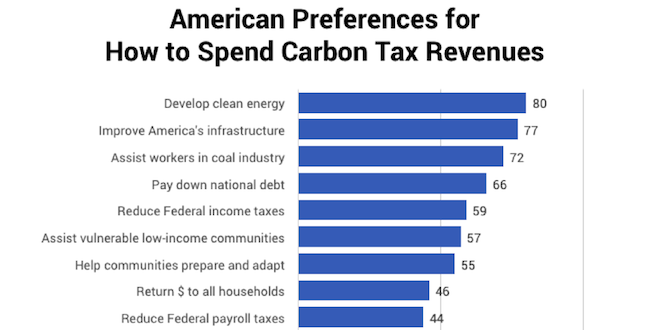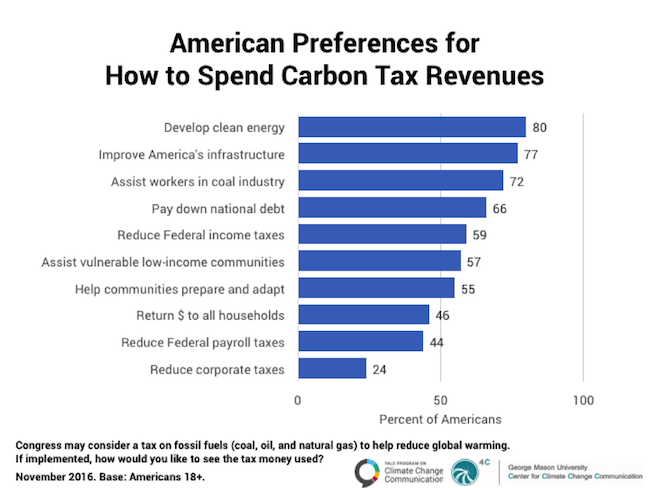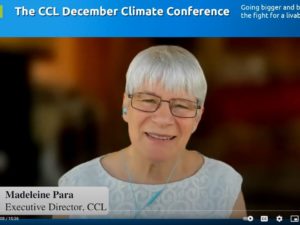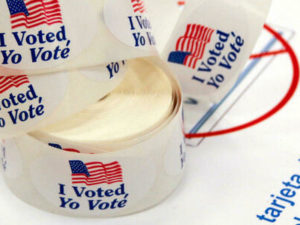Where should the money go? Dividend vs. clean energy
By Flannery Winchester
Recently, the Yale Program on Climate Change Communication published some new research on Americans’ willingness to pay a carbon tax. In YPCCC’s announcement about this new research, they explained:
Respondents were asked: “If a tax on fossil fuels (coal, oil, and natural gas) to help reduce global warming were to cost your household $X more each year in higher energy bills, would you support or oppose it?” We found that the average American is willing to pay $177 per year. Translating this to respondents’ energy bills based on their state of residence, we found that American households are, on average, willing to pay 14.4% more for energy in support of a carbon tax.
This is hopeful news! Though it’s just one poll, it could indicate that the public understands the value of accounting for the true cost of our emissions, and support is growing for a price on carbon.
Use for the revenue
There’s one piece of the poll results that may give our volunteers pause, though: respondents’ preferences for how the revenue is used. The respondents were asked, “Congress may consider a tax on fossil fuels (coal, oil, and natural gas) to help reduce global warming. If implemented, how would you like to see the tax money used?”
In response, 80% said they support money being invested in clean energy. Other popular choices for the revenue were to improve infrastructure, assist workers in the coal industry, assist vulnerable low-income communities, and more. Just 46% of the respondents chose “Return the money to all households” as one of their preferences. Here’s the full breakdown:
Obviously, in CCL we’ve been lobbying for nearly a decade on Carbon Fee and Dividend legislation, which would return carbon tax revenue to households, making it a fee. In the face of a poll like this, should we adjust our strategy? Some journalists think so, but in fact, we have several key reasons to keep advocating for a fee and dividend approach.
Visibility is crucial
This is a big one: the money that’s raised from the carbon tax or fee needs to be visible to the American people. With visibility comes accountability—an assurance that the money is going where it’s really supposed to go. Dr. Danny Richter, CCL’s Vice President of Legislative Affairs, said, “Once the money goes to those other programs like clean energy, it will be largely invisible.” That could undercut ongoing support for the fee. Americans likely wouldn’t be able to see and trust those clean energy investment promises the same way they would see and trust a dividend return in their own bank account. We need a carbon price that can not only get enacted but will stay in place no matter who is in power, and that requires ongoing public support.
Support for low- and middle-income households
The idea behind a carbon tax or fee is that it internalizes the costs of burning dirty fuels—companies pay money on the front end, instead of society paying on the back end in the form of human health impacts and a changing climate. That means that as a carbon fee rises, we will likely see a slight increase in the cost of fuel and other products and services. CCL advocates for a dividend approach so low- and middle-income families are protected from those price increases—in fact, most families in the bottom 60% of income would come out ahead if they received a regular carbon dividend.
Without that dividend, those families may struggle with increasing costs, especially as the carbon fee rises to the level needed to sufficiently reduce emissions. Even if solar or energy efficiency programs were offered, there is evidence to suggest that those programs are mostly utilized by wealthier Americans. By contrast, the dividend is the most straightforward way to support low- and middle-income Americans as we transition to cleaner energy sources.
One poll doesn’t tell the whole story
The Yale Program on Climate Change Communication does wonderful work, but one poll can’t always provide the full context around an issue. Polling methodology and how a question is worded can make a big difference in the results. For comparison, this poll from National Surveys on Energy and Environment shows a much smaller difference between support for a revenue-neutral carbon tax and one that’s used to fund clean energy, and no difference in support among Republicans.
It may be that many poll respondents have simply never heard of or considered a dividend, thus reducing support for the concept. Certainly with the increased visibility of the dividend approach, thanks to CCL’s ongoing work and the advocacy of the Climate Leadership Council, it’s easy to imagine that support for the dividend approach will continue to rise.
Bottom line
Public opinion and polling matter, but ultimately what matters most to pass legislation is the support of Congress—for good or bad, that doesn’t always track directly with public opinion. In deciding what bills to introduce and to vote for, members of Congress will consider their constituents, their donors, the political atmosphere, and other factors.
For that reason, it’s possible that legislators might find a carbon fee and dividend approach more politically viable than an outright carbon tax with revenues invested in clean energy. This is particularly true in a Republican-controlled Congress.
“If Republicans introduce a carbon pricing bill that takes a big chunk out of emissions and would take care of the lower-income households of our society, then CCL would likely recommend that our volunteers support it,” Dr. Richter said, even if that bill is structured differently than our preferred legislation.
But until there’s such a bill for us to consider, CCL will continue to build on the incredible momentum we have for the fee and dividend approach.







